Ming Wen
Kling-Foley: Multimodal Diffusion Transformer for High-Quality Video-to-Audio Generation
Jun 24, 2025Abstract:We propose Kling-Foley, a large-scale multimodal Video-to-Audio generation model that synthesizes high-quality audio synchronized with video content. In Kling-Foley, we introduce multimodal diffusion transformers to model the interactions between video, audio, and text modalities, and combine it with a visual semantic representation module and an audio-visual synchronization module to enhance alignment capabilities. Specifically, these modules align video conditions with latent audio elements at the frame level, thereby improving semantic alignment and audio-visual synchronization. Together with text conditions, this integrated approach enables precise generation of video-matching sound effects. In addition, we propose a universal latent audio codec that can achieve high-quality modeling in various scenarios such as sound effects, speech, singing, and music. We employ a stereo rendering method that imbues synthesized audio with a spatial presence. At the same time, in order to make up for the incomplete types and annotations of the open-source benchmark, we also open-source an industrial-level benchmark Kling-Audio-Eval. Our experiments show that Kling-Foley trained with the flow matching objective achieves new audio-visual SOTA performance among public models in terms of distribution matching, semantic alignment, temporal alignment and audio quality.
Multi-Programming Language Sandbox for LLMs
Oct 30, 2024



Abstract:We introduce MPLSandbox, an out-of-the-box multi-programming language sandbox designed to provide unified and comprehensive feedback from compiler and analysis tools for Large Language Models (LLMs). It can automatically identify the programming language of the code, compiling and executing it within an isolated sub-sandbox to ensure safety and stability. In addition, MPLSandbox also integrates both traditional and LLM-based code analysis tools, providing a comprehensive analysis of generated code. MPLSandbox can be effortlessly integrated into the training and deployment of LLMs to improve the quality and correctness of their generated code. It also helps researchers streamline their workflows for various LLM-based code-related tasks, reducing the development cost. To validate the effectiveness of MPLSandbox, we integrate it into training and deployment approaches, and also employ it to optimize workflows for a wide range of real-world code-related tasks. Our goal is to enhance researcher productivity on LLM-based code-related tasks by simplifying and automating workflows through delegation to MPLSandbox.
What's Wrong with Your Code Generated by Large Language Models? An Extensive Study
Jul 08, 2024
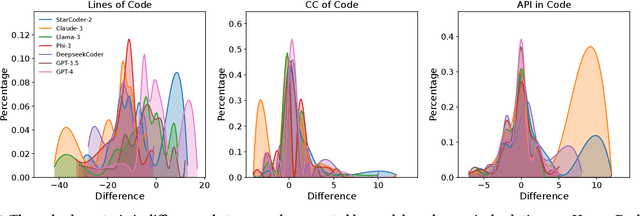


Abstract:The increasing development of large language models (LLMs) in code generation has drawn significant attention among researchers. To enhance LLM-based code generation ability, current efforts are predominantly directed towards collecting high-quality datasets and leveraging diverse training technologies. However, there is a notable lack of comprehensive studies examining the limitations and boundaries of these existing methods. To bridge this gap, we conducted an extensive empirical study evaluating the performance of three leading closed-source LLMs and four popular open-source LLMs on three commonly used benchmarks. Our investigation, which evaluated the length, cyclomatic complexity and API number of the generated code, revealed that these LLMs face challenges in generating successful code for more complex problems, and tend to produce code that is shorter yet more complicated as compared to canonical solutions. Additionally, we developed a taxonomy of bugs for incorrect codes that includes three categories and 12 sub-categories, and analyze the root cause for common bug types. Furthermore, to better understand the performance of LLMs in real-world projects, we manually created a real-world benchmark comprising 140 code generation tasks. Our analysis highlights distinct differences in bug distributions between actual scenarios and existing benchmarks. Finally, we propose a novel training-free iterative method that introduces self-critique, enabling LLMs to critique and correct their generated code based on bug types and compiler feedback. Experimental results demonstrate that our approach can significantly mitigate bugs and increase the passing rate by 29.2% after two iterations, indicating substantial potential for LLMs to handle more complex problems.
Generalization-Enhanced Code Vulnerability Detection via Multi-Task Instruction Fine-Tuning
Jun 06, 2024



Abstract:Code Pre-trained Models (CodePTMs) based vulnerability detection have achieved promising results over recent years. However, these models struggle to generalize as they typically learn superficial mapping from source code to labels instead of understanding the root causes of code vulnerabilities, resulting in poor performance in real-world scenarios beyond the training instances. To tackle this challenge, we introduce VulLLM, a novel framework that integrates multi-task learning with Large Language Models (LLMs) to effectively mine deep-seated vulnerability features. Specifically, we construct two auxiliary tasks beyond the vulnerability detection task. First, we utilize the vulnerability patches to construct a vulnerability localization task. Second, based on the vulnerability features extracted from patches, we leverage GPT-4 to construct a vulnerability interpretation task. VulLLM innovatively augments vulnerability classification by leveraging generative LLMs to understand complex vulnerability patterns, thus compelling the model to capture the root causes of vulnerabilities rather than overfitting to spurious features of a single task. The experiments conducted on six large datasets demonstrate that VulLLM surpasses seven state-of-the-art models in terms of effectiveness, generalization, and robustness.
An Extensive Study on Adversarial Attack against Pre-trained Models of Code
Nov 23, 2023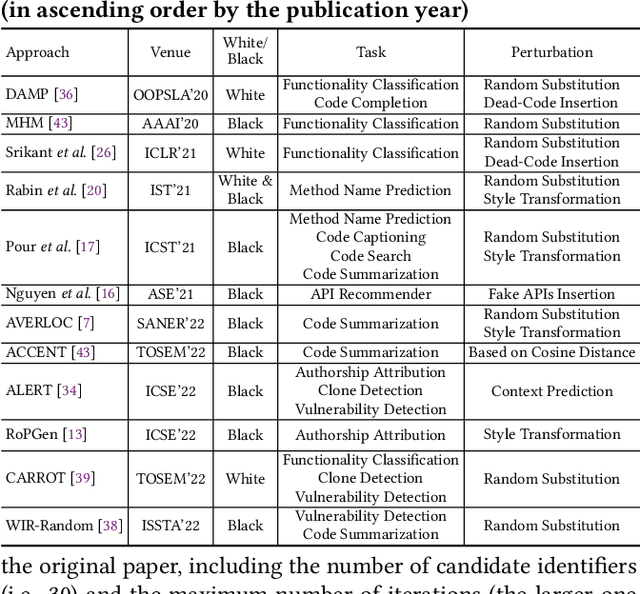
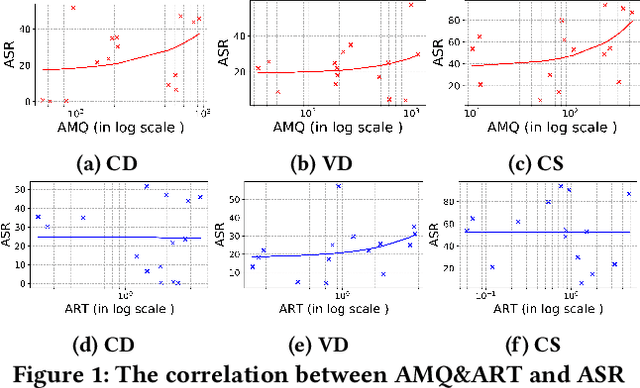

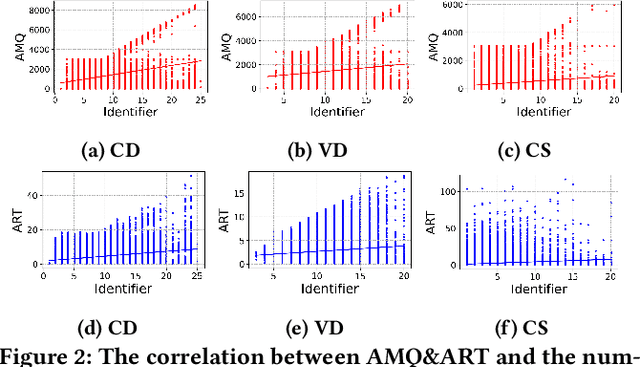
Abstract:Transformer-based pre-trained models of code (PTMC) have been widely utilized and have achieved state-of-the-art performance in many mission-critical applications. However, they can be vulnerable to adversarial attacks through identifier substitution or coding style transformation, which can significantly degrade accuracy and may further incur security concerns. Although several approaches have been proposed to generate adversarial examples for PTMC, the effectiveness and efficiency of such approaches, especially on different code intelligence tasks, has not been well understood. To bridge this gap, this study systematically analyzes five state-of-the-art adversarial attack approaches from three perspectives: effectiveness, efficiency, and the quality of generated examples. The results show that none of the five approaches balances all these perspectives. Particularly, approaches with a high attack success rate tend to be time-consuming; the adversarial code they generate often lack naturalness, and vice versa. To address this limitation, we explore the impact of perturbing identifiers under different contexts and find that identifier substitution within for and if statements is the most effective. Based on these findings, we propose a new approach that prioritizes different types of statements for various tasks and further utilizes beam search to generate adversarial examples. Evaluation results show that it outperforms the state-of-the-art ALERT in terms of both effectiveness and efficiency while preserving the naturalness of the generated adversarial examples.
MEMO: Coverage-guided Model Generation For Deep Learning Library Testing
Aug 02, 2022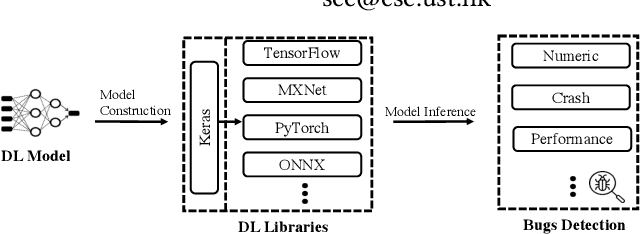
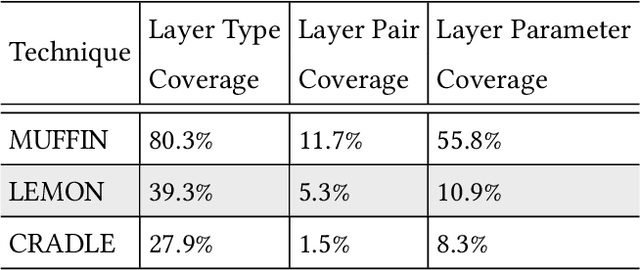
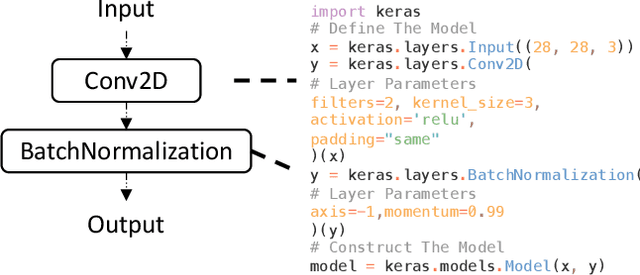
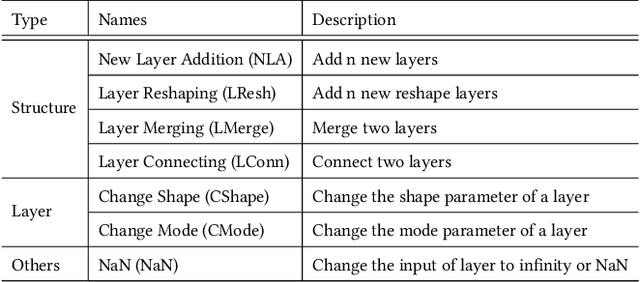
Abstract:Recent deep learning (DL) applications are mostly built on top of DL libraries. The quality assurance of these libraries is critical to the dependable deployment of DL applications. A few techniques have thereby been proposed to test DL libraries by generating DL models as test inputs. Then these techniques feed those DL models to DL libraries for making inferences, in order to exercise DL libraries modules related to a DL model's execution. However, the test effectiveness of these techniques is constrained by the diversity of generated DL models. Our investigation finds that these techniques can cover at most 11.7% of layer pairs (i.e., call sequence between two layer APIs) and 55.8% of layer parameters (e.g., "padding" in Conv2D). As a result, we find that many bugs arising from specific layer pairs and parameters can be missed by existing techniques. In view of the limitations of existing DL library testing techniques, we propose MEMO to efficiently generate diverse DL models by exploring layer types, layer pairs, and layer parameters. MEMO: (1) designs an initial model reduction technique to boost test efficiency without compromising model diversity; and (2) designs a set of mutation operators for a customized Markov Chain Monte Carlo (MCMC) algorithm to explore new layer types, layer pairs, and layer parameters. We evaluate MEMO on seven popular DL libraries, including four for model execution (TensorFlow, PyTorch and MXNet, and ONNX) and three for model conversions (Keras-MXNet, TF2ONNX, ONNX2PyTorch). The evaluation result shows that MEMO outperforms recent works by covering 10.3% more layer pairs, 15.3% more layer parameters, and 2.3% library branches. Moreover, MEMO detects 29 new bugs in the latest version of DL libraries, with 17 of them confirmed by DL library developers, and 5 of those confirmed bugs have been fixed.
DeepFD: Automated Fault Diagnosis and Localization for Deep Learning Programs
May 04, 2022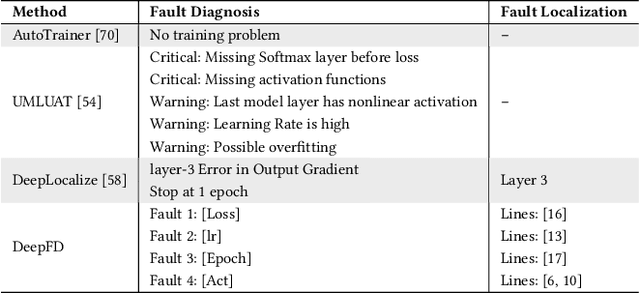
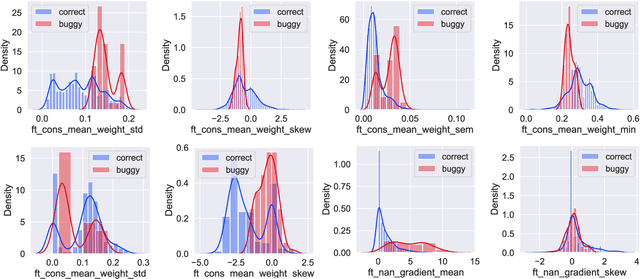

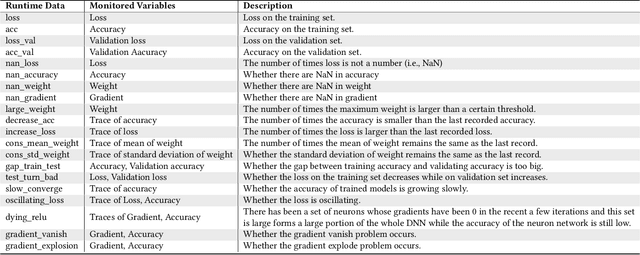
Abstract:As Deep Learning (DL) systems are widely deployed for mission-critical applications, debugging such systems becomes essential. Most existing works identify and repair suspicious neurons on the trained Deep Neural Network (DNN), which, unfortunately, might be a detour. Specifically, several existing studies have reported that many unsatisfactory behaviors are actually originated from the faults residing in DL programs. Besides, locating faulty neurons is not actionable for developers, while locating the faulty statements in DL programs can provide developers with more useful information for debugging. Though a few recent studies were proposed to pinpoint the faulty statements in DL programs or the training settings (e.g. too large learning rate), they were mainly designed based on predefined rules, leading to many false alarms or false negatives, especially when the faults are beyond their capabilities. In view of these limitations, in this paper, we proposed DeepFD, a learning-based fault diagnosis and localization framework which maps the fault localization task to a learning problem. In particular, it infers the suspicious fault types via monitoring the runtime features extracted during DNN model training and then locates the diagnosed faults in DL programs. It overcomes the limitations by identifying the root causes of faults in DL programs instead of neurons and diagnosing the faults by a learning approach instead of a set of hard-coded rules. The evaluation exhibits the potential of DeepFD. It correctly diagnoses 52% faulty DL programs, compared with around half (27%) achieved by the best state-of-the-art works. Besides, for fault localization, DeepFD also outperforms the existing works, correctly locating 42% faulty programs, which almost doubles the best result (23%) achieved by the existing works.
STURE: Spatial-Temporal Mutual Representation Learning for Robust Data Association in Online Multi-Object Tracking
Jan 19, 2022



Abstract:Online multi-object tracking (MOT) is a longstanding task for computer vision and intelligent vehicle platform. At present, the main paradigm is tracking-by-detection, and the main difficulty of this paradigm is how to associate the current candidate detection with the historical tracklets. However, in the MOT scenarios, each historical tracklet is composed of an object sequence, while each candidate detection is just a flat image, which lacks the temporal features of the object sequence. The feature difference between current candidate detection and historical tracklets makes the object association much harder. Therefore, we propose a Spatial-Temporal Mutual {Representation} Learning (STURE) approach which learns spatial-temporal representations between current candidate detection and historical sequence in a mutual representation space. For the historical trackelets, the detection learning network is forced to match the representations of sequence learning network in a mutual representation space. The proposed approach is capable of extracting more distinguishing detection and sequence representations by using various designed losses in object association. As a result, spatial-temporal feature is learned mutually to reinforce the current detection features, and the feature difference can be relieved. To prove the robustness of the STURE, it is applied to the public MOT challenge benchmarks and performs well compared with various state-of-the-art online MOT trackers based on identity-preserving metrics.
Fast Test Input Generation for Finding Deviated Behaviors in Compressed Deep Neural Network
Dec 06, 2021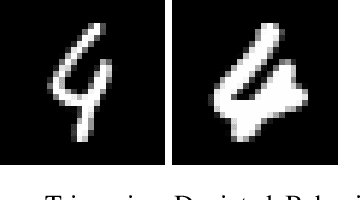
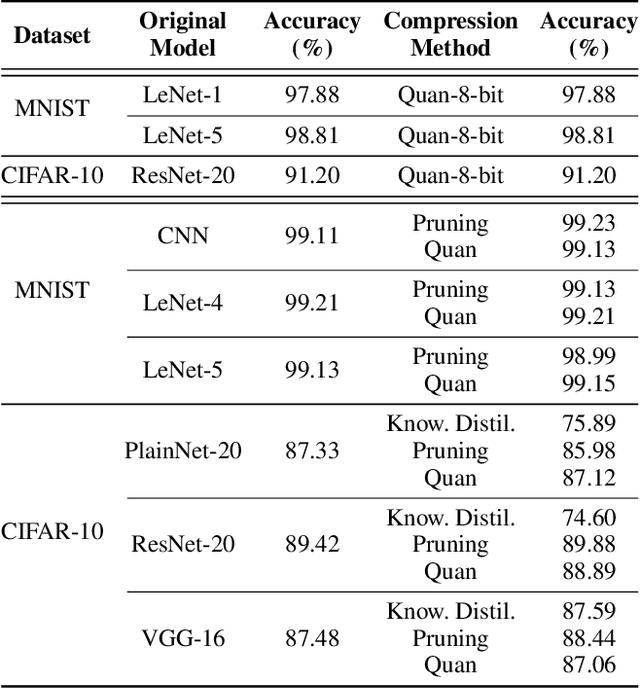
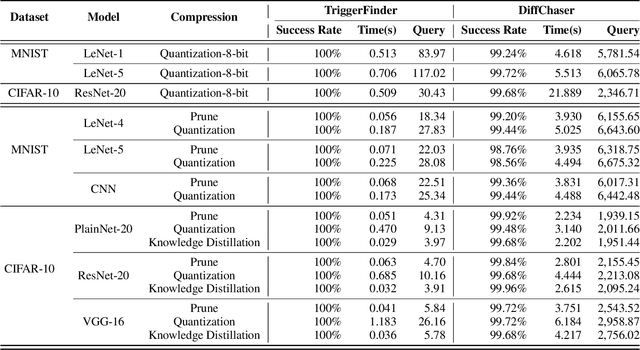
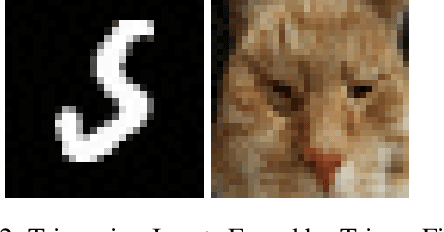
Abstract:Model compression can significantly reduce sizes of deep neural network (DNN) models so that large, sophisticated models after compression can be deployed on resource-limited mobile and IoT devices. However, model compression often introduces deviated behaviors into a compressed model: the original and compressed models output different prediction results for the same input. Hence, it is critical to warn developers and help them comprehensively evaluate possible consequences of such behaviors before deployment. To this end, we propose TriggerFinder, a novel, effective and efficient testing approach to automatically identifying inputs to trigger deviated behaviors in compressed models. Given an input i as a seed, TriggerFinder iteratively applies a series of mutation operations to change i until the resulting input triggers a deviated behavior. However, compressed models usually hide their architecture and gradient information; without such internal information as guidance, it becomes difficult to effectively and efficiently trigger deviated behaviors. To tackle this challenge, we propose a novel fitness function to determine the mutated input that is closer to the inputs that can trigger the deviated predictions. Furthermore, TriggerFinder models this search problem as a Markov Chain process and leverages the Metropolis-Hasting algorithm to guide the selection of mutation operators. We evaluated TriggerFinder on 18 compressed models with two datasets. The experiment results demonstrate that TriggerFinder can successfully find triggering inputs for all seed inputs while the baseline fails in certain cases. As for efficiency, TriggerFinder is 5.2x-115.8x as fast as the baselines. Furthermore, the queries required by TriggerFinder to find one triggering input is only 51.8x-535.6x as small as the baseline.
SemMT: A Semantic-based Testing Approach for Machine Translation Systems
Dec 03, 2020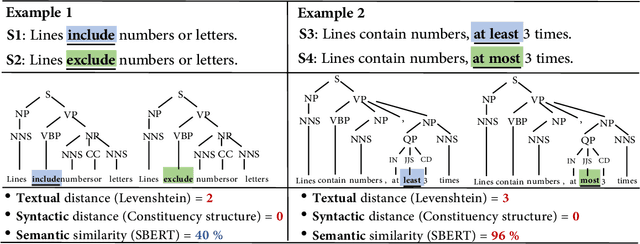
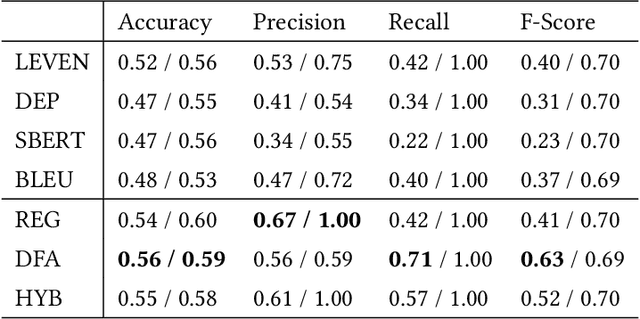
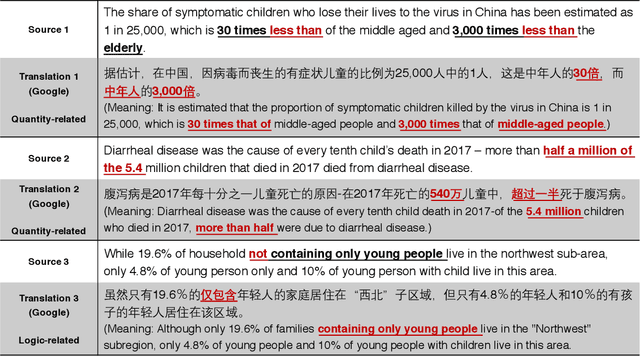
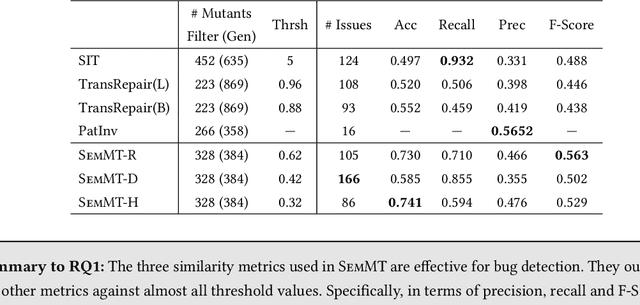
Abstract:Machine translation has wide applications in daily life. In mission-critical applications such as translating official documents, incorrect translation can have unpleasant or sometimes catastrophic consequences. This motivates recent research on testing methodologies for machine translation systems. Existing methodologies mostly rely on metamorphic relations designed at the textual level (e.g., Levenshtein distance) or syntactic level (e.g., the distance between grammar structures) to determine the correctness of translation results. However, these metamorphic relations do not consider whether the original and translated sentences have the same meaning (i.e., Semantic similarity). Therefore, in this paper, we propose SemMT, an automatic testing approach for machine translation systems based on semantic similarity checking. SemMT applies round-trip translation and measures the semantic similarity between the original and translated sentences. Our insight is that the semantics expressed by the logic and numeric constraint in sentences can be captured using regular expressions (or deterministic finite automata) where efficient equivalence/similarity checking algorithms are available. Leveraging the insight, we propose three semantic similarity metrics and implement them in SemMT. The experiment result reveals SemMT can achieve higher effectiveness compared with state-of-the-art works, achieving an increase of 21% and 23% on accuracy and F-Score, respectively. We also explore potential improvements that can be achieved when proper combinations of metrics are adopted. Finally, we discuss a solution to locate the suspicious trip in round-trip translation, which may shed lights on further exploration.
 Add to Chrome
Add to Chrome Add to Firefox
Add to Firefox Add to Edge
Add to Edge